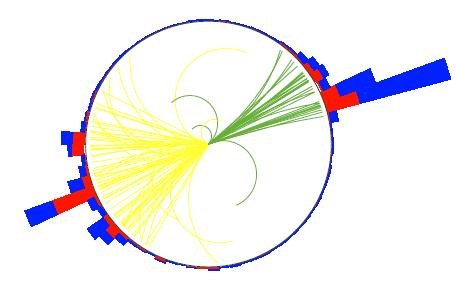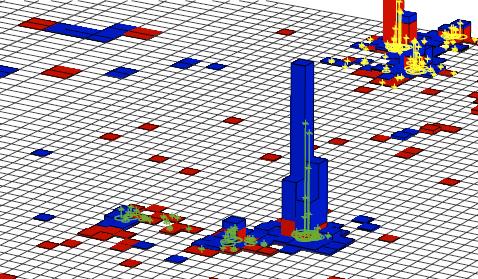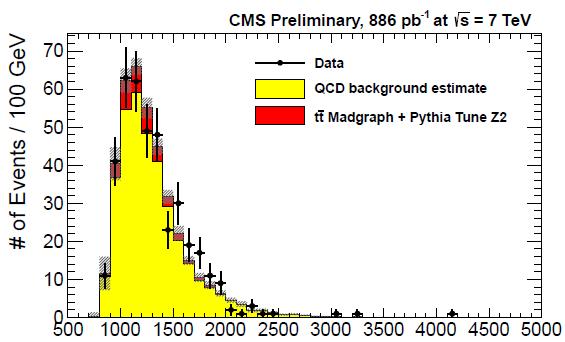New heavy gauge bosons, electrically neutral and quite similar to Z bosons, are the result of adding a simple one-dimensional unitary group to the group structure of the Standard Model. Such an extension, which appears minimal and as such "perturbs" very little the low-energy behaviour of the theory, is actually the possible outcome of quite important extensions of the model. But I do not wish to delve in the details of the various flavours of U(1) extensions that have been proposed, on where these come from, and on why they are more or less appealing to theorists. I rather concentrate on the signature we experimentalists could observe if such new bosons -call them Z'- existed.
The particular signature of Z' decays that CMS considered in their recently published search which I report on today is that of a top quark pair: this is the result of having to deal with a Z' which preferentially couples to third-generation fermions, such as indeed the top quark is. So if you search for a top quark pair -something which has been the main occupation of many physicists for a decade or two now- you might be in some case bump into one pair which was produced not by the simple splitting of a gluon by strong interaction, but by the decay of a heavy Z' boson. But how could you realize that ?
Indeed it is not too hard. One can always compute the total invariant mass of the top-antitop pair, and see whether a bump appears in the mass spectrum, indicating that a fraction of the collected pairs does come from the decay of an object of well-defined mass. The problem is that we are hypothesizing that this Z' is quite massive -say above 1 TeV, where the Tevatron could not observe it. In such case, few such particles are produced even at the LHC, and one must be careful to sort out backgrounds and optimize the selection tools.
The search for Z'->tt by CMS is extremely nice, in my opinion, because it focuses on the all-hadronic signature of top quark pairs. Now, if you know my personal background you realize that I of course must be interested: I started my career in CDF by looking for all-hadronic decays of top quark pairs well before the top quark was even proven to exist... But what is the "all-hadronic" signature anyway ?
A top quark always decays to a W boson and a b-quark; the W boson in turn decays two thirds of the time into another pair of quarks. So if you have two top quarks (okay, a top and an antitop, but the antiparticle behaves the same way for the purpose of this discussion) you may have, 2/3 * 2/3 = 4/9 = 45% of the time, a final state composed of six energetic quarks, which fragment producing six jets of hadrons.
The one described is the so-called "all-hadronic" signature of top pairs: it is the hardest to find, because of the huge background from QCD processes producing six jet final states, which is a thousand times more frequent in hadron collisions. But it is also the most frequent, due to the large branching fraction of W bosons to quark pairs. So if one is in search of a Z' and so looks for very high-mass top quark pairs, where statistics are poor, one may be tempted to look for exactly that signature. That is what CMS did, with 850 inverse picobarns of proton-proton collisions delivered this year by the LHC collider at CERN.
The real nice things start now. What happens when a 1-TeV particle decays into two 173-GeV bodies ? Those tops are quite heavy, but they receive a very large kick by the decay, and so they fly out in opposite directions at close to light speed. In other words, they get a large boost, which makes things very interesting. After each top decays to three quarks, those quarks in turn share the boost of their parent, so they end up flying out close together, despite the large mass of the top quark imparts them with additional kicks in random directions (well, not exactly random, but let's omit this detail).
The end result is something like what you can examine in the following two event displays, which are real CMS data selected to represent one of the most clean candidates of the searched process.

Above, you can see a transverse view of the detector. Inner tracks reconstructed from charged particles belonging to the two top quark decays curve in the strong axial magnetic field; particles then hit the calorimeters, depositing there their energy and allowing a precise measurement of the whole event. The length of the bars in the calorimeters are proportional to the measured energy. Note that the "yellow" jet in particular shows in this transversal view its substructure quite clearly: three individual sub-jets are observed, coming from the hadronization of the b-quark and the two quark emitted from the W boson.

And above, the "lego" view of the calorimeter energy deposits of another very energetic top-antitop event candidate. Here the calorimeter must be thought of as a cylinder which is "unrolled" onto a flat surface. The bars represent energy readings in the electromagnetic inner section of the detector (in red) and the hadronic section (in blue). Here a three-subjets structure is evident in both fat jets.
So the two "jets" emitted back to back in these events are really fat: they are much fatter than jets produced by the fragmentation of a single light quark. Indeed: top quarks are heavy, so they kick the three final state quarks a little here and there; the trio then hits the calorimeter and leaves there a fat jet signature which has a substructure betraying the fact that these are in fact three sub-jets. Can we actually reconstruct the top quark mass and the W boson mass from three- and two-sub-jet combinations in these candidate events ? Yes we can, as shown below.

Here a nice W boson mass peak from top decay events (the red component, modeled by simulation) is observed as the total mass of a fat jet made actually by two sub-jets, in events selected to enrich the top-quark content. The ones shown are single-lepton top pair candidates and do not belong to the Z' search discussed here, but they provide a nice confirmation that the jet substructure allows the measurement of the component masses.
In the end, the analysts search for pairs of such high-mass jets, and after additional selection requirements, reconstruct the total mass of the top-antitop candidate. This would show a bump if there was a significant Z' signal in the data. A sample spectrum is shown below.

Here the small component expected from real top-antitop decays is shown in red. Beware: these are the "normal" top pairs produced by QCD interactions; a Z' would produce a more localized bump. Observe how the QCD background (from other than top-pair production), in yellow, is dominant in this selection, even at this very high energy: indeed, there is not a large advantage in signal-to-noise fraction by going to high-energy, since the majority of top quark pairs are produced by QCD "at threshold", i.e. with little extra energy; the same goes for the backgrounds; but selecting "boosted top" pairs does not win much in signal fraction.
Anyway, in the spectrum above (and in another obtained with a different signal selection strategy) no signal is observable, so upper limits are placed on the production rate of Z' bosons decaying into pairs of top quarks. These limits, compared to theoretical predictions for the production rate that Z' bosons should have if the relative theoretical models represented Nature (the bitch, not the magazine), finally allow CMS to exclude that such Z' bosons exist, if their mass is in the range where the experimental limit is below the theoretical expectation. The excluded range is, for a particular model of a "Kaluza-Klein gluon", between 1 and 1.5 TeV. But these are details which you are probably uninterested about. What is really interesting, I stress it, is the technique, which will become -well, it already is- a very powerful tool for exotic searches in the future. So my congratulations to the unnamed CMS colleagues who performed the search! (As you might know, I am forbidden to attach explicit names to any public CMS result...)




Comments